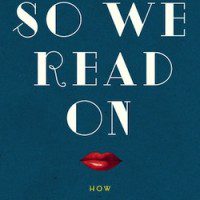The biography of a book—a variety of nonfiction that combines elements of memoir, criticism, and history—seems to be experiencing a bit of a heyday. There was Michael Gorra’s critically acclaimed The Portrait of a Novel (on Henry James’s masterpiece) in 2012, and this year so far we’ve had Sarah Churchwell’s Carless People (on The Great Gatsby), Rebecca Mead’s My Life In Middlemarch, and Kevin Birmingham’s The Most Dangerous Book (on Joyce’s Ulysses). The latest example is So We Read On: How The Great Gatsby Came To Be and Why It Endures, by Maureen Corrgian, book reviewer for NPR’s Fresh Air.
The burning questions at the center of these books are summed up by Corrigan’s subtitle: what influenced the making of these novels and how did they become classics? We seem to be endlessly fascinated by any attempt to explain how a great work made its way to the page. Churchwell’s book about The Great Gatsby focused specifically on this question, arguing that the media attention devoted for the better part of a year to a sensational murder near New York set the stage for Fitzgerald’s masterpiece. Corrigan’s book takes a much wider view, carrying us from Fitzgerald’s upbringing to a classroom of high schoolers discussing the novel today.
The issue of how a classic novel came to be considered great is much less frequently examined. We tend to take for granted that the cream of literary history naturally rises to the top. But even a cursory comparison of a literary anthology from, say, the 1950s with one published today proves how shifting the sands of literary reputation are. Corrigan describes at length, in perhaps the book’s most fascinating chapter, Gatsby’s own rocky ride to the top. After being largely panned by critics, it fell into obscurity until World War II, when it was sent overseas to soldiers in a cheap paperback edition that increased the book’s circulation six-fold from its initial sales in 1923. From there, key players from Scribner’s ensured that the novel’s brilliance was belatedly and widely recognized.
Aware of the transience of canonical status, writers of the biography of a book can sound a bit like evangelists eager to secure a more permanent place for their chosen novels. This is particularly true in Mead’s case as she argues for a resurgence in appreciation for George Eliot’s colossus Middlemarch. The much flashier and shorter Gatsby is in significantly less danger of obsolescence. Nonetheless, Corrigan’s proselytizing is apparent throughout So We Read On—she calls herself at one point “an itinerant preacher for the greatness of Gatsby.” She is out to convince us that the novel is not only “great” but “our Greatest American Novel.” What it does better than any other work, according to Corrigan, is elevate prose to the “unearthly” and “nail who we want to be as Americans.”
The problem Gatsby faces, Corrigan feels, is oversaturation, particularly during the high school years when nearly every American teenager is force-fed the book before they can fully appreciate its subtlety and beauty. Unfortunately, as she notes, it is unevenly represented on college syllabi (at least by her survey of the Ivy Leagues), where it perhaps more properly belongs. Corrigan has certainly done her part, teaching The Great Gatsby for thirty odd years at Georgetown University. In her continual rereading of the book, she has discovered that the beauty of its prose never fades. She says of its famous final paragraphs, “They never get old those words. If they do, I’ll know it’s time to hang up my reading glasses.”

Corrigan’s book is chock-full of insights that enrich any reading of The Great Gatsby. She notes the pervasiveness of water imagery, particularly drowning, and pauses to point out how the accumulated rejections that the poor, young Fitzgerald endured made their way into the characterization of Gatsby. Corrigan also quotes a letter from Fitzgerald to H. L. Mencken in which he explains that he has taken as his model the “masculine” Brothers Karamazov rather than the “feminine” Portrait of a Lady. When the novel failed to sell well, Fitzgerald was sure the book was too masculine for the largely female fiction-reading audience.
Perhaps the most illuminating part of So We Read On is the chapter on Gatsby’s links to the conventions of hard-boiled fiction, such as the focus on male buddies, the portrayal of women as either femme fatales or corpses, and the obsession with out-of-control women drivers. All of this may do little to convince us of the novel’s superlative status, but it does perhaps explain the novel’s lack of strong female characters, which doesn’t seem to bother Corrigan. Although she addresses contemporary concerns about Fitzgerald’s portrayal of non-WASP characters and readers’ interest in the potential homosexuality of Nick, Corrigan is surprisingly mum about the fact that Gatsby, as a type of hard-boiled “bromance” (her word), spectacularly fails the Bechdel test—something that should, in my estimation, weaken its nomination for “Great American Novel” status.
Corrigan focuses almost exclusively on issues of class in the novel and is on a mission to set straight the pervasive “misreading of Gatsby, now amplified a million-fold” by the recent Baz Luhrmann film, “that the novel is the literary equivalent of a luxury spending spree.” At its core is not excess but longing, she argues, that fundamentally American state of desiring what is just beyond reach. “It’s not the green light, stupid; it’s Gatsby’s reaching for it that’s the crucial all-American symbol of the novel,” she writes, correcting naïve readers eagerly looking for easy symbols.
Listeners of Fresh Air could probably hear Corrigan’s distinctive voice in that last quote. It echoes throughout the book, written very much in the style of her on-air reviews, which could be described as incisive with a dash of folksy flippancy. One passage reads, “Myrtle and Gatsby have already been discarded by these wealthy survivors, who’re as cold as that fried chicken they’re getting ready to gnaw.” Or, referring to her lectures on Gatsby for the NEH’s Big Read Program, which promoted the idea that reading makes us better Americans, she writes, “I want to talk about the novel as a noir that surveys the rotten underbelly of the American Dream. Take that cheery assurance that Good readers make good citizens and stuff it down a drain.”
If you find Corrigan’s style refreshing, then you are in for a treat. If not, then you may have a hard time sticking with the book. But in that case you would miss equally splendid passages such as: “[Fitzgerald’s] best characters dive into life with abandon and then must stay afloat. By the end of their stories, they’re almost always going under, if not altogether sunk, weighted down by money worries, overwhelming desire, the burden of their pasts.” If you can make it past writing that sometimes feels forced and condescending, you’re never far from an anecdote or insight that makes you want to rummage through the basement for your musty, bright blue paperback with those sad eyes and floating red lips.
That, of course, is the goal of the biography of a book—to bring you back to the original with a new appreciation. Yet it should also leave you feeling that you’d like to have the same rich experience the author has had, reading and rereading the book over the years. Unfortunately, something in Corrigan’s stance as a Gatsby “expert” and professorial arbiter of taste erects a barrier to the novel that the biography of a book is designed to dissolve. Rebecca Mead, a writer for The New Yorker, had no such pretensions to expertise when she set out to write about her favorite book, Middlemarch. She takes the reader along on her journey behind the scenes, making us feel like companions rather than students. Corrigan’s reminders of how the book has been read simplistically and wrongly—many of which are drawn from her experiences lecturing to hinterland audiences on her “Big Read” tours—have the effect of making us feel as if she thinks we are, well, “stupid.”
At the outset of her book, Corrigan cites as her models “midcentury intellectuals” such as Alfred Kazin and Lionel Trilling, who “wrote for a wide audience of educated nonspecialists,” a worthy goal that she ultimately lives up to. In the closing chapter, Corrigan visits her old high school in Astoria, New York, not far from the site of Gatsby’s mansion. As we see her walking the halls like a disoriented student again, and being caught off-guard by students’ reactions to the book, we find ourselves able to look at the world of Gatsby through her eyes. It’s a more agreeable position than feeling like we’re sitting in a lecture hall silently absorbing her far-off words of wisdom. It’s also a bit refreshing to hear her say, in the book’s final passages, “There are still parts of The Great Gatsby that I haven’t figured out either, but I want to.” The true measure of Corrigan’s success in So We Read On is that she makes us want to as well.




